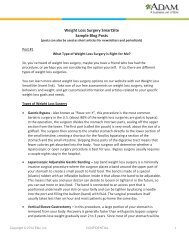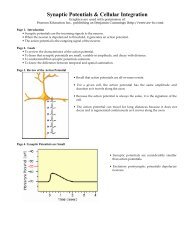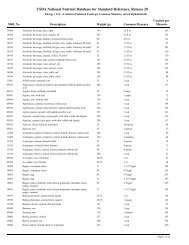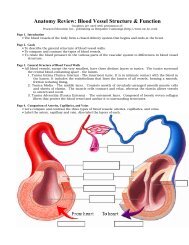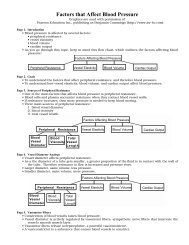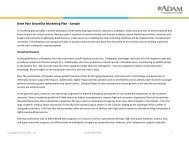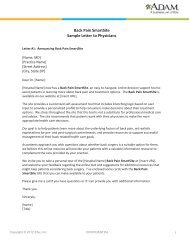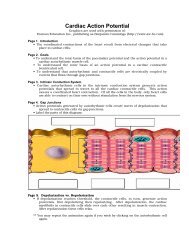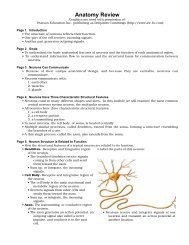The Cardiac Cycle - Pearson
The Cardiac Cycle - Pearson
The Cardiac Cycle - Pearson
You also want an ePaper? Increase the reach of your titles
YUMPU automatically turns print PDFs into web optimized ePapers that Google loves.
<strong>The</strong> <strong>Cardiac</strong> <strong>Cycle</strong>Graphics are used with permission of:<strong>Pearson</strong> Education Inc., publishing as Benjamin Cummings (http://www.aw-bc.com)Page 1. Introduction• <strong>The</strong> cardiac cycle includes all the events related to the flow of blood through the heart during onecomplete heartbeat.Page 2. Goals• To list the phases of the cardiac cycle in consecutive order.• To recognize that the pressure changes determine valve action and direction of blood flow throughthe heart.• To relate an ECG and heart sounds to events of the cardiac cycle.Page 3. Heart Valves• During the cardiac cycle, heart valves open and close in response to differences in blood pressure ontheir two sides.• <strong>The</strong> Heart Valves:• Pulmonary semilunar valve• Aortic Semilunar Valve• Left AV valve or Bicuspid valve or Mitral valve• Right AV valve or Tricuspid valvePage 4. Overview of <strong>Cardiac</strong> <strong>Cycle</strong>• Phases of the <strong>Cardiac</strong> <strong>Cycle</strong>1. Ventricular Filling - Occurs during mid to late diastole.2. Ventricular Systole - Includes isovolumetric contraction and ventricular ejection.3. Isovolumetric Relaxation - Occurs during early diastole.Page 5. Ventricular Filling: Passive• Occurs during mid to late diastole, when the heart chambers are relaxed.• Blood flows passively into the atria, through open AV valves, and into the ventricles, where thepressure is lower.Page 6. Ventricular Filling: Atrial Contraction• Atria contract, forcing the remaining blood into the ventricles.• Blood flows through both sides of the heart at the same time.Page 7. Ventricular Systole: Contraction• Isovolumetric contraction: Ventricles contract and intraventricular pressure rises, closing the AVvalves. Briefly, ventricles are completely closed chambers.Page 8. Ventricular Systole: Ejection• Ventricular ejection: Rising ventricular pressure forces semilunar valves open. Blood is ejected fromthe heart into the aorta and pulmonary trunk.Page 9. Isovolumetric Relaxation• Ventricles relax and ventricular pressure drops. Blood backflows, closing semilunar valves.Ventricles are totally closed off again.Page 10. Atrial Filling• Meanwhile, the atria have been filling with blood. When atrial pressure exceeds ventricularpressure, AV valves open and ventricular filling, phase 1 begins again.Page 11. Ventricular and Atrial Contraction• Although we have been highlighting the flow of blood on the right side of the heart, remember thatboth atria contract at the same time and both ventricles contract at the same time.Page 12. Control of Blood Flow by Pressure• Pressure changes reflect the alternating contraction and relaxation of the heart.
• Blood moves along a pressure gradient (from higher to lower pressure) through any availableopening.• Pressure changes cause the heart valves to open and close, which keeps the blood flowing in theforward direction.** Now is a good time to go to quiz questions 1 and 2:• Click the Quiz button on the left side of the screen.• After answering question 2, click the Back to Topic button on the left side of the screen.• To get back to where you left off, click on the scrolling page list at the top of the screen andchoose "Page 13. Overview: Graphs and Heart".Page 13. Overview: Graphs and Heart• During ventricular ejection phase, ventricular pressure rises higher than aortic pressure. This isnecessary to open the semilunar valve.• Only a little more than half of the blood is ejected during ventricular ejection.Page 14. Left Atrial Pressure• As you go through pages 14-19, you may take notes on this diagram:Page 15. Left Ventricular PressurePage 16. Aortic PressurePage 17. Ventricular VolumePage 18. ECGPage 19. All Graphs
Page 20. Summary** Now is a good time to go to quiz questions 3-6:• Click the Quiz button on the left side of the screen.• Click on the scrolling page list at the top of the screen and choose "3. <strong>Cardiac</strong> <strong>Cycle</strong> Phase".• Work through quiz questions 3-6.Notes on Quiz Questions:Quiz Question #1: Blood Flow through Heart• This question asks you to trace the blood through the right side of the heart.Quiz Question #2: Valves• This question asks you to predict when the valves are open or closed during the various stages ofthe cardiac cycle.Quiz Questions #3a, 4a, 5a, 6a: <strong>Cardiac</strong> <strong>Cycle</strong> Phase• <strong>The</strong>se question asks you to view a diagram of the heart and predict what stage of the cell cycleit's in. You may take notes on the diagrams below. <strong>The</strong> dye-labeled blood has been coloredlight here to make it more visible.Quiz Question #3b, 4b, 5b, 6b: <strong>Cardiac</strong> <strong>Cycle</strong> Graphs• <strong>The</strong>se questions asks you to predict the correct phase of the cardiac cycle by viewing an ECG,graph of ventricular volume, and a graph of pressures. You may want to take notes on thisdiagram:
Study Questions on the <strong>Cardiac</strong> <strong>Cycle</strong>:1. (Page 1.) What is a cardiac cycle?2. (Page 3.) What opens and closes the heart valves?3. (Page 4.) List the three phases of the <strong>Cardiac</strong> <strong>Cycle</strong>.4. (Pages 5-10.) Match the stages of the cardiac cycle to their description.1a. Ventricular Filling: Passive v. Ventricles contract and intraventricularpressure rises, closing the AV valves.1b. Ventricular Filling: Atrial Contraction w. Ventricles relax and ventricular pressuredrops. Blood backflows, closing semilunarvalves.2a. Ventricular Systole: IsovolumetricContractionx. Blood flows passively into the atria, throughopen AV valves, and into the ventricles.2b. Ventricular Systole: Ejection y. Rising ventricular pressure forces semilunarvalves open. Blood is ejected from theheart.3. Isovolumetric Relaxation z. Atria contract, forcing the remaining bloodinto the ventricles.5. (Page 6.) True or false: Blood passes through the bicuspid valve at the same time blood is also passingthrough the tricuspid valve.6. (Page 7.) What closes the AV valves?7. (Page 8.) What opens the semilunar valves?8. (Page 9.) What closes the semilunar valves?9. (Page 10.) What opens the AV valves?10. (Page 11.) True or false: <strong>The</strong> right side of the heart contracts, then the left side of the heart contract.11. (Page 12.) What is the relationship between pressure inside a chamber of the heart and the state of theheart muscle (relaxed or contracted)?12. (Page 12.) Blood always moves from ____ pressure to ____ pressure.13. (Page 12.) What causes heart valves to open and close?14. (Page 12.) Predict if the AV and semilunar valves are open or closed during the following phases of thecardiac cycle by circling the appropriate answer on this chart:State of AV ValvesState of Semilunar ValvesIsovolumetric Contraction Open Closed Open ClosedIsovolumetric Relaxation Open Closed Open ClosedVentricular Ejection Open Closed Open ClosedVentricular Filling Open Closed Open Closed
15. (Pages 14-19.) What is happening to the volume of blood inside the ventricles during each labeled partof the graph below?16. (Pages 14-19.) What is happening to the pressure inside the ventricles during each labeled part of thegraph below? Explain.17. (Pages 14-19.) What is happening to the depolarization, repolarization and contraction of the atria andventricles during each labeled part of the graph below?18. Pages 14-19.) On the graph below, which number corresponds to:ventricular ejection isovolumetric relaxation ventricular filling isovolumetric contraction



